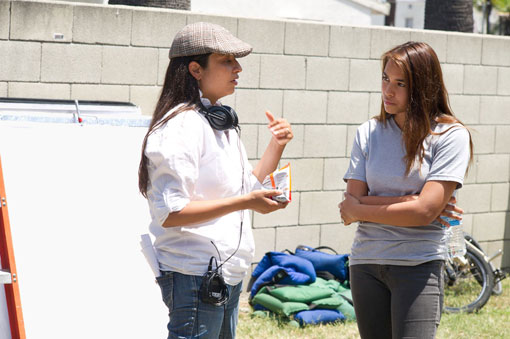“Write what you know.” It’s an age-old dictum for aspiring writers—and it applies to filmmakers, too. Aurora Guerrero, a self-defined queer Chicana, followed that rule to create Mosquita y Mari, a coming-of-age film about a friendship between two Chicana teenagers that deepens into a romance. The film, which premiered at the 2012 Sundance Film Festival, is also a celebration of identity—cultural as well as sexual.
Mosquita y Mari’s protagonists are Yolanda (Mosquita—“little fly”), a straight-A student under the careful watch of her parents; and Mari, the oldest child of an undocumented family struggling to make ends meet. The story is set in Los Angeles’ Huntington Park neighborhood, but it draws deeply on Guerrero’s upbringing in northern California as a child of Mexican immigrants and a middle-school friendship she describes as “more than just a friendship—it was also my first love.” The importance of cultural identity was instilled in her from an early age. Guerrero, now 40, remembers how her mother would march into school and instruct the teachers to pronounce her brothers’ names José and Alejandro instead of Joseph and Alex.
Mosquita y Mari is political as well as personal. Guerrero, who received a Master of Fine Arts from the California Institute of the Arts (CalArts) in 1999, wanted to give voice to LGBT, Chicano and undocumented immigrant communities, which “are very marginalized and very much silenced by mainstream media,” she says. A love story would dispel the notion that same-sex relationships are unnatural. “I wanted people who don’t identify as queer [to] watch and all of a sudden find themselves reminiscing about their young loves,” says Guerrero. “And [it would be] these two girls who are evoking those feelings [. . .] not so much different than what they experienced.”
Guerrero also hoped that LGBT Latino audiences would see themselves validated by the film—much as Guerrero herself felt when, as an undergraduate student, she encountered the work of feminist Chicana writers Gloria Anzaldúa and Cherríe Moraga. “[Their work] broke down all these stereotypes of what I thought it meant to be queer,” she recalls. “I, in turn, wanted to put out films showing characters [whose] identities are intersecting in very real, authentic ways.”
Guerrero’s strong community roots and sense of ethnic identity have been crucial to her development as a filmmaker. After graduating from CalArts, she formed the filmmaking collective Womyn Image-Makers with three other queer Chicana artist-activists. Together, they made the widely successful Pura Lengua and Viernes Girl. When it came time to raise money for Mosquita y Mari in 2011, Guerrero again turned to her community—this time via Kickstarter, a popular crowd-funding platform. During a 30-day campaign, she and her team raised $82,000, the entire production budget for the film.
Mosquita y Mari is currently on the film festival circuit, taking Guerrero home to San Francisco and as far away as Japan and Switzerland. It airs in select theaters in New York and Los Angeles in August 2012, and will be broadcast on cable and online at the end of this year. Guerrero is already developing ideas for new projects, including another independent film and a TV pilot. She says she will continue to explore themes of immigration, class and Latino identity generally, but “always [with] a queer algo” to reflect the LGBT voice.





